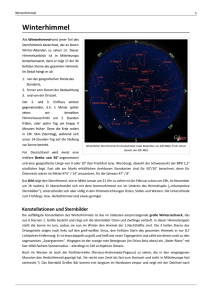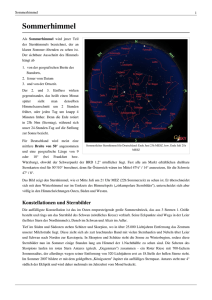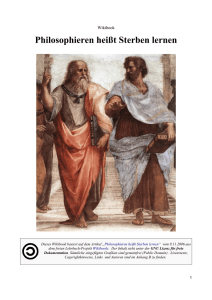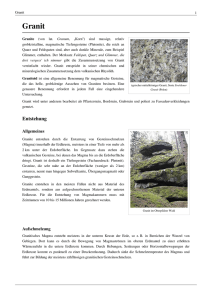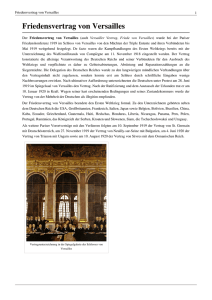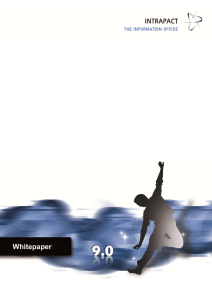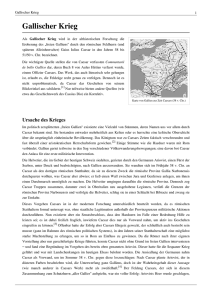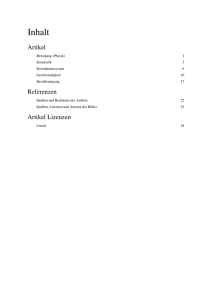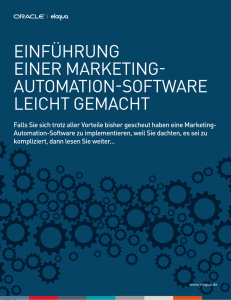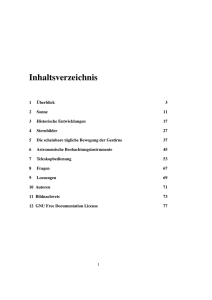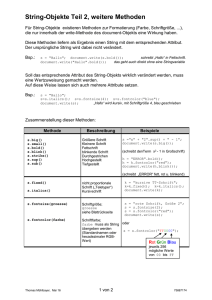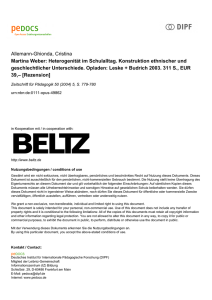Liste der Datenbankmanagementsysteme
Werbung
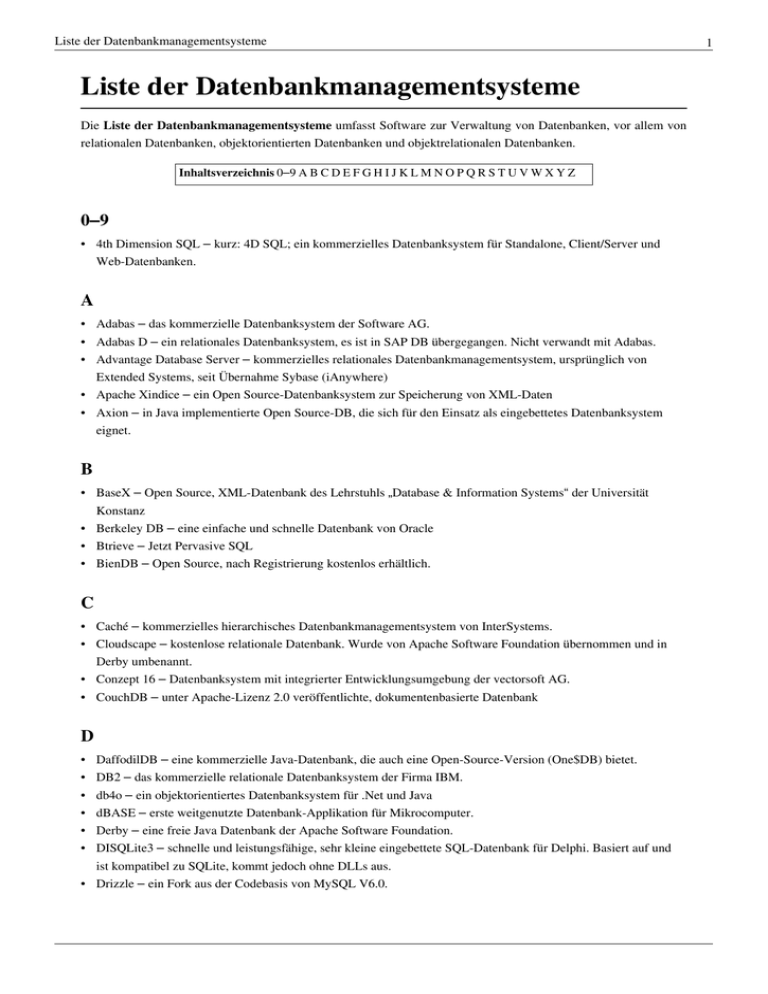
Liste der Datenbankmanagementsysteme Liste der Datenbankmanagementsysteme Die Liste der Datenbankmanagementsysteme umfasst Software zur Verwaltung von Datenbanken, vor allem von relationalen Datenbanken, objektorientierten Datenbanken und objektrelationalen Datenbanken. Inhaltsverzeichnis 0–9 A B C D E F G H I J K L M N O P Q R S T U V W X Y Z 0–9 • 4th Dimension SQL – kurz: 4D SQL; ein kommerzielles Datenbanksystem für Standalone, Client/Server und Web-Datenbanken. A • Adabas – das kommerzielle Datenbanksystem der Software AG. • Adabas D – ein relationales Datenbanksystem, es ist in SAP DB übergegangen. Nicht verwandt mit Adabas. • Advantage Database Server – kommerzielles relationales Datenbankmanagementsystem, ursprünglich von Extended Systems, seit Übernahme Sybase (iAnywhere) • Apache Xindice – ein Open Source-Datenbanksystem zur Speicherung von XML-Daten • Axion – in Java implementierte Open Source-DB, die sich für den Einsatz als eingebettetes Datenbanksystem eignet. B • BaseX – Open Source, XML-Datenbank des Lehrstuhls „Database & Information Systems“ der Universität Konstanz • Berkeley DB – eine einfache und schnelle Datenbank von Oracle • Btrieve – Jetzt Pervasive SQL • BienDB – Open Source, nach Registrierung kostenlos erhältlich. C • Caché – kommerzielles hierarchisches Datenbankmanagementsystem von InterSystems. • Cloudscape – kostenlose relationale Datenbank. Wurde von Apache Software Foundation übernommen und in Derby umbenannt. • Conzept 16 – Datenbanksystem mit integrierter Entwicklungsumgebung der vectorsoft AG. • CouchDB – unter Apache-Lizenz 2.0 veröffentlichte, dokumentenbasierte Datenbank D • • • • • • DaffodilDB – eine kommerzielle Java-Datenbank, die auch eine Open-Source-Version (One$DB) bietet. DB2 – das kommerzielle relationale Datenbanksystem der Firma IBM. db4o – ein objektorientiertes Datenbanksystem für .Net und Java dBASE – erste weitgenutzte Datenbank-Applikation für Mikrocomputer. Derby – eine freie Java Datenbank der Apache Software Foundation. DISQLite3 – schnelle und leistungsfähige, sehr kleine eingebettete SQL-Datenbank für Delphi. Basiert auf und ist kompatibel zu SQLite, kommt jedoch ohne DLLs aus. • Drizzle – ein Fork aus der Codebasis von MySQL V6.0. 1 Liste der Datenbankmanagementsysteme E • EntropyDB – eine freie Objektdatenbank implementiert in Objective-C für das iPhone OS • Essbase – ist ein multidimensionales Datenbanksystem (MDBMS) zur Erstellung von analytischen Auswertungen. • EXAdata – In-Memory-zentriertes Datenbanksystem von Oracle, besonders geeignet für Real Time Data Warehousing. • eXist – eine freie XML-Datenbank F • FastObjects t7 – eine kommerzielle Datenbank, die POET entwickelt hat und von Versant weitergepflegt wird (POET wurde von Versant übernommen) • FileMaker – eine kommerzielle Standalone-, Client/Server- und Web-Datenbank von FileMaker Inc. (100 %-ige Tochtergesellschaft der Firma Apple) • Firebird – Open-Source-Spin-Off von InterBase • FrontBase – kommerziell entwickeltes System, frei benutzbar, kostenpflichtige Supportpläne G • • • • GadflyB5 – ein relationales Open Source-Datenbanksystem, in Python programmiert. GNU SQL – ein relationales Open Source-Datenbanksystem für Unix/Linux Greenplum – für massiv-parallele Analysen, BI und Data Warehouse optimierter PostgreSQL Fork GUPTA-SQLBase – Datenbank der Gupta Technologies. Später als SQLWindows eines der ersten relationalen Datenbanksysteme, das unter Microsoft Windows lief. H • Hazelcast – eine in Java implementierte Datenbank (Hazel Bilisim Limited 2008 Istanbul. Lizenz: Apache Lizenz Version 2.0 • HSQLDB – eine in Java implementierte Datenbank (früher bekannt als Hypersonic) in OpenOffice.org Base integriert. • H2 – Java Datenbank, neues Projekt vom HSQLDB Initiator • Helios neXt – Datenbanksystem der ISD Dortmund als PDM/PLM System I • • • • • • IMS – die hierarchische Datenbank der IBM im Mainframe-Bereich Informix – von der Firma Informix entwickelt, wird nun von IBM weitergepflegt Ingres – ein relationales Datenbanksystem von der University of California, Berkeley. InterBase – von der Firma Borland entwickelt ITTIA-DB FUEL – DB-System für eingebettete und mobile Anwendungen IDMS – Integrated Database Management System – Netzwerk-Datenbank von Cullinet, seit 1989 von Computer Associates weiterentwickelt – Datenbank kann beides Netzwerk DML und SQL. 2 Liste der Datenbankmanagementsysteme J • JDataStore – eine Java Datenbank von der Firma Borland • Jet Engine – von Microsoft, ursprünglich die Standard-Engine für Microsoft Access K • Kexi – eine freie integrierte Datenbankmanagementanwendung als Teil von KOffice L • LibreOffice Base – Standalone-Datenbank des LibreOffice-Paketes der Document Foundation • Lotus Notes – ein verteiltes, dokumenten-orientiertes Datenbanksystem von Lotus Software, einer Tochterfirma von IBM. M • MariaDB – relationales Datenbanksystem Fork von MySQL. Enthält vor allem einige zusätzliche Storage-Engins. • MaxDB – ehemals SAP DB, seit Release 7.7 SAP MaxDB, wird von der SAP entwickelt und vertrieben. Dient allen SAP-Produkten wie SAP R/3, NetWeaver, Business ByDesign als Datenbankplattform • McKoi – eine in Java entwickelte Open Source Datenbank • MetaKit – eine in C++ entwickelte Open Source Datenbank • Microsoft Access – das relationale Datenbanksystem von Microsoft für PCs • Microsoft SQL Server – das relationale Datenbanksystem von Microsoft für große Anwendungen • MonetDB – eine Sammlung von quelloffenen Datenbankprodukten. Anwendungsschwerpunkte: Data-Mining, OLAP, GIS, XML-Verarbeitung • MongoDB – eine in C++ entwickelte dokumentenbasierte Datenbank • MySQL – das relationale Datenbanksystem aus Schweden als Open-Source. Vielfach auf Internet-Servern eingesetzt. N • Neo4j - in Java implementierte Graphendatenbank • NexusDB – Datenbank für Delphi • NonStopSQL – Relationale Datenbank für die Non Stop-Systeme von Hewlett-Packard (vormals Tandem Computers). • Strozzi NoSQL (RDBMS) O • • • • • • Objectivity/DB – objektorientierte Datenbank von Objectivity ObjectStore – objektorientiertes Datenbanksystem von Progress Software Ocelot – relationales Datenbankmanagementsystem, das den SQL1999-Standard unterstützt. octobase – Datenbanksystem für Microsoft Windows, nutzt MySQL, PostgreSQL und SQLite als Datenbank. One$DB – in Java implementierte Open-Source-Variante der DaffodilDB. Oracle Database – das kommerzielle, relationale Datenbanksystem der Firma Oracle. • Oracle Rdb für OpenVMS (Datenbanksystem) (siehe engl. Artikel Oracle Rdb) – kommerzielles, relationales Datenbanksystem der Firma Oracle speziell für OpenVMS-Betriebssysteme (bis 1994 DEC Rdb der Firma Digital Equipment Corporation). • OpenOffice.org Base – Standalone-Datenbank des OpenOffice.org Paketes 3 Liste der Datenbankmanagementsysteme • O2 – objektorientierte Datenbank (OODBM) der Firma O2 Technology P • • • • • • • • • Paradox – eine dateibasierte Windows-Datenbank von Corel (früher Borland) Papyrus – relationale Datenbank integriert in ein Office Paket Pervasive SQL – relationale und transaktionale DB (früher Btrieve) Progress – relationales Datenbanksystem in Verbindung mit einer 4GL-Entwicklungsumgebung Polyhedra und Polyhedra FlashLite – eine speicherbasierte, relationale Datenbank für, aber nicht begrenzt auf, eingebettete Systeme von Enea AB Postgres Plus – ein kommerzielle Variante von PostgreSQL mit einigen Zusatzfunktionen von EnterpriseDB PostgreSQL – eine objektrelationale Datenbank als Open Source. PointBase Embedded – Relationale SQL Java Datenbank für J2EE PointBase Micro – Relationale SQL Java Datenbank für J2ME und J2SE Umgebung von DataMirror Q • Quadcap Embeddable Database (QED) – von der Firma Quadcap Software. In Java implementierte Open Source-Datenbank. R • Redabas – dBase Clone • R:Base – war die erste relationale Datenbank für PCs S • SAP MaxDB – relationales Datenbanksystem Fork von Adabas D, seit 2000 unter GPL/LGPL Lizenz für Versionen 7.2 bis 7.4 mit Bezeichnung SAP DB, ab Version 7.5 mit Bezeichnung MaxDB und seit Version 7.7 mit Bezeichnung SAP MaxDB • Secondo – ein an der FernUniversität in Hagen entwickeltes erweiterbares Open-Source-Datenbanksystem • Sedna – Open-Source-XML-Datenbank, die von der Russian Academy of Sciences (ISP RAS) entwickelt wurde • SESAM/SQL Server – relationales Datenbanksystem von der Firma Fujitsu Siemens Computers. Es läuft nur auf BS2000/OSD-Anlagen. • SIM DB/DC-System – OLTP-Datenbank- und Transaktionsmonitorsystem der Firma SIM-Basis • SmallSQL – komplett in Java geschriebenes Datenbanksystem • Solid – relationale Datenbank der Firma Solid Information Technology • SQLite – Open-Source-Standalone-Datenbank. • Sybase – das relationale Datenbanksystem der Firma Sybase. 4 Liste der Datenbankmanagementsysteme T • • • • • Teradata – Massiv Paralleles Processing-Datenbank der Firma Teradata Ltd Transbase – Datenbanksystem der Firma Transaction Software GmbH TITANIUM – Multi-Model Architecture der Firma Savitar Cooperation TM1 – Multidimensionales Datenbanksystem der Firma Cognos (z.Z. IBM) TurboDB – Eingebettetes SQL Datenbanksystem der Firma dataweb GmbH, das sowohl speziell für Delphi als auch komplett in C# geschrieben verfügbar ist. • TXcontent – PHP-basiertes CMS System für sog. CDS (cluster data store). U • UDS – Netzwerk-Datenbanksystem der Firma Fujitsu Siemens Computers • UniVerse – multidimensionale oder extended relational Datenbank der Firma IBM • UniData – multidimensionale oder extended relational Datenbank der Firma IBM V • Versant – OODBMS der Firma Versant Corp. • Visual FoxPro – Datenbank/Entwicklungsumgebung von Microsoft • VistaDB – reine .Net-Datenbank von VistaDB Software, Inc. • Valentina 2 – objektrelationale Datenbank der Firma Paradigma Software Inc. X • xBase – dBASE-Derivat • Xbase++ – dBASE/Clipper-Derivat mit objektorientierter Spracherweiterung für graphische Oberflächen und unterstützt auch Visual FoxPro 3.0/5.0 Datenbanken. Y • YARD-SQL Z • Zope Object Database 5 Quelle(n) und Bearbeiter des/der Artikel(s) Quelle(n) und Bearbeiter des/der Artikel(s) Liste der Datenbankmanagementsysteme Quelle: http://de.wikipedia.org/w/index.php?oldid=102187016 Bearbeiter: 08-15, 7Pinguine, A1000, Akkakk, Anders Andersen, Armadillo ECM, BertholdWagner, Binningench1, Boshomi, BuSchu, BuZZdEE.BuzZ, Bugdigger, Christian Sakowski, Cú Faoil, Daniel Bovensiepen, DasBee, DinDaDa, Don Magnifico, Dplusplus, DutiesAtHand, Eco schranzer, Emkaer, Fabian Schölzel, Farino, Fasse, Frank Roeing, GFJ, Gargoyle Guldbamser, Gnu1742, Godp, Goldzahn, Halut, Head, Hetzi, Holgerjakobs, Horcrux7, Hydro, Hyperdieter, Infosuche, JPense, JPlenert, Jesi, JoachimG, Johanan, Julius-m, Kaneiderdaniel, Kgfleischmann, Knoerz, LKD, Leupold, Levin, Liesel, Mabuligari, Magic R, Martin1978, Matze12, Meph666, Michelangelo, Mideal, Millbart, Mot2, Nico b., Nilspausdd, Nina, Nolispanmo, OlafsWissen, Orangwiki, PDD, Poc, R.K.A.L., Rblock, Rca06, Roterraecher, S.K., Saehrimnir, Servus, Shikeishu, Shmia, Simplicius, Solphusion, Sparti, StYxXx, Tetris L, Tuthmosis VII, Volker Fritzsche, Wingsofcourage, Woches, ZweiZahn, 178 anonyme Bearbeitungen Lizenz Wichtiger Hinweis zu den Lizenzen Die nachfolgenden Lizenzen bezieht sich auf den Artikeltext. Im Artikel gezeigte Bilder und Grafiken können unter einer anderen Lizenz stehen sowie von Autoren erstellt worden sein, die nicht in der Autorenliste erscheinen. Durch eine noch vorhandene technische Einschränkung werden die Lizenzinformationen für Bilder und Grafiken daher nicht angezeigt. An der Behebung dieser Einschränkung wird gearbeitet. Das PDF ist daher nur für den privaten Gebrauch bestimmt. Eine Weiterverbreitung kann eine Urheberrechtsverletzung bedeuten. Creative Commons Attribution-ShareAlike 3.0 Unported - Deed Diese "Commons Deed" ist lediglich eine vereinfachte Zusammenfassung des rechtsverbindlichen Lizenzvertrages (http:/ / de. wikipedia. org/ wiki/ Wikipedia:Lizenzbestimmungen_Commons_Attribution-ShareAlike_3. 0_Unported) in allgemeinverständlicher Sprache. Sie dürfen: • das Werk bzw. den Inhalt vervielfältigen, verbreiten und öffentlich zugänglich machen • Abwandlungen und Bearbeitungen des Werkes bzw. Inhaltes anfertigen Zu den folgenden Bedingungen: • • Namensnennung — Sie müssen den Namen des Autors/Rechteinhabers in der von ihm festgelegten Weise nennen. Weitergabe unter gleichen Bedingungen — Wenn Sie das lizenzierte Werk bzw. den lizenzierten Inhalt bearbeiten, abwandeln oder in anderer Weise erkennbar als Grundlage für eigenes Schaffen verwenden, dürfen Sie die daraufhin neu entstandenen Werke bzw. Inhalte nur unter Verwendung von Lizenzbedingungen weitergeben, die mit denen dieses Lizenzvertrages identisch, vergleichbar oder kompatibel sind. Wobei gilt: • • Verzichtserklärung — Jede der vorgenannten Bedingungen kann aufgehoben werden, sofern Sie die ausdrückliche Einwilligung des Rechteinhabers dazu erhalten. Sonstige Rechte — Die Lizenz hat keinerlei Einfluss auf die folgenden Rechte: • • • • Die gesetzlichen Schranken des Urheberrechts und sonstigen Befugnisse zur privaten Nutzung; Das Urheberpersönlichkeitsrecht des Rechteinhabers; Rechte anderer Personen, entweder am Lizenzgegenstand selber oder bezüglich seiner Verwendung, zum Beispiel Persönlichkeitsrechte abgebildeter Personen. Hinweis — Im Falle einer Verbreitung müssen Sie anderen alle Lizenzbedingungen mitteilen, die für dieses Werk gelten. Am einfachsten ist es, an entsprechender Stelle einen Link auf http:/ / creativecommons. org/ licenses/ by-sa/ 3. 0/ deed. de einzubinden. Haftungsbeschränkung Die „Commons Deed“ ist kein Lizenzvertrag. Sie ist lediglich ein Referenztext, der den zugrundeliegenden Lizenzvertrag übersichtlich und in allgemeinverständlicher Sprache, aber auch stark vereinfacht wiedergibt. Die Deed selbst entfaltet keine juristische Wirkung und erscheint im eigentlichen Lizenzvertrag nicht. GNU Free Documentation License Version 1.2, November 2002 Copyright (C) 2000,2001,2002 Free Software Foundation, Inc. 51 Franklin St, Fifth Floor, Boston, MA 02110-1301 USA Everyone is permitted to copy and distribute verbatim copies of this license document, but changing it is not allowed. 0. PREAMBLE The purpose of this License is to make a manual, textbook, or other functional and useful document "free" in the sense of freedom: to assure everyone the effective freedom to copy and redistribute it, with or without modifying it, either commercially or noncommercially. Secondarily, this License preserves for the author and publisher a way to get credit for their work, while not being considered responsible for modifications made by others. This License is a kind of "copyleft", which means that derivative works of the document must themselves be free in the same sense. It complements the GNU General Public License, which is a copyleft license designed for free software. We have designed this License in order to use it for manuals for free software, because free software needs free documentation: a free program should come with manuals providing the same freedoms that the software does. But this License is not limited to software manuals; it can be used for any textual work, regardless of subject matter or whether it is published as a printed book. We recommend this License principally for works whose purpose is instruction or reference. 1. APPLICABILITY AND DEFINITIONS This License applies to any manual or other work, in any medium, that contains a notice placed by the copyright holder saying it can be distributed under the terms of this License. Such a notice grants a world-wide, royalty-free license, unlimited in duration, to use that work under the conditions stated herein. The "Document", below, refers to any such manual or work. Any member of the public is a licensee, and is addressed as "you". You accept the license if you copy, modify or distribute the work in a way requiring permission under copyright law. A "Modified Version" of the Document means any work containing the Document or a portion of it, either copied verbatim, or with modifications and/or translated into another language. A "Secondary Section" is a named appendix or a front-matter section of the Document that deals exclusively with the relationship of the publishers or authors of the Document to the Document's overall subject (or to related matters) and contains nothing that could fall directly within that overall subject. (Thus, if the Document is in part a textbook of mathematics, a Secondary Section may not explain any mathematics.) The relationship could be a matter of historical connection with the subject or with related matters, or of legal, commercial, philosophical, ethical or political position regarding them. The "Invariant Sections" are certain Secondary Sections whose titles are designated, as being those of Invariant Sections, in the notice that says that the Document is released under this License. If a section does not fit the above definition of Secondary then it is not allowed to be designated as Invariant. The Document may contain zero Invariant Sections. If the Document does not identify any Invariant Sections then there are none. The "Cover Texts" are certain short passages of text that are listed, as Front-Cover Texts or Back-Cover Texts, in the notice that says that the Document is released under this License. A Front-Cover Text may be at most 5 words, and a Back-Cover Text may be at most 25 words. A "Transparent" copy of the Document means a machine-readable copy, represented in a format whose specification is available to the general public, that is suitable for revising the document straightforwardly with generic text editors or (for images composed of pixels) generic paint programs or (for drawings) some widely available drawing editor, and that is suitable for input to text formatters or for automatic translation to a variety of formats suitable for input to text formatters. A copy made in an otherwise Transparent file format whose markup, or absence of markup, has been arranged to thwart or discourage subsequent modification by readers is not Transparent. An image format is not Transparent if used for any substantial amount of text. A copy that is not "Transparent" is called "Opaque". Examples of suitable formats for Transparent copies include plain ASCII without markup, Texinfo input format, LaTeX input format, SGML or XML using a publicly available DTD, and standard-conforming simple HTML, PostScript or PDF designed for human modification. Examples of transparent image formats include PNG, XCF and JPG. Opaque formats include proprietary formats that can be read and edited only by proprietary word processors, SGML or XML for which the DTD and/or processing tools are not generally available, and the machine-generated HTML, PostScript or PDF produced by some word processors for output purposes only. The "Title Page" means, for a printed book, the title page itself, plus such following pages as are needed to hold, legibly, the material this License requires to appear in the title page. For works in formats which do not have any title page as such, "Title Page" means the text near the most prominent appearance of the work's title, preceding the beginning of the body of the text. A section "Entitled XYZ" means a named subunit of the Document whose title either is precisely XYZ or contains XYZ in parentheses following text that translates XYZ in another language. (Here XYZ stands for a specific section name mentioned below, such as "Acknowledgements", "Dedications", "Endorsements", or "History".) To "Preserve the Title" of such a section when you modify the Document means that it remains a section "Entitled XYZ" according to this definition. The Document may include Warranty Disclaimers next to the notice which states that this License applies to the Document. These Warranty Disclaimers are considered to be included by reference in this License, but only as regards disclaiming warranties: any other implication that these Warranty Disclaimers may have is void and has no effect on the meaning of this License. 2. VERBATIM COPYING You may copy and distribute the Document in any medium, either commercially or noncommercially, provided that this License, the copyright notices, and the license notice saying this License applies to the Document are reproduced in all copies, and that you add no other conditions whatsoever to those of this License. You may not use technical measures to obstruct or control the reading or further copying of the copies you make or distribute. However, you may accept compensation in exchange for copies. If you distribute a large enough number of copies you must also follow the conditions in section 3. You may also lend copies, under the same conditions stated above, and you may publicly display copies. 3. COPYING IN QUANTITY If you publish printed copies (or copies in media that commonly have printed covers) of the Document, numbering more than 100, and the Document's license notice requires Cover Texts, you must enclose the copies in covers that carry, clearly and legibly, all these Cover Texts: Front-Cover Texts on the front cover, and Back-Cover Texts on the back cover. Both covers must also clearly and legibly identify you as the publisher of these copies. The front cover must present the full title with all words of the title equally prominent and visible. You may add other material on the covers in addition. Copying with changes limited to the covers, as long as they preserve the title of the Document and satisfy these conditions, can be treated as verbatim copying in other respects. If the required texts for either cover are too voluminous to fit legibly, you should put the first ones listed (as many as fit reasonably) on the actual cover, and continue the rest onto adjacent pages. If you publish or distribute Opaque copies of the Document numbering more than 100, you must either include a machine-readable Transparent copy along with each Opaque copy, or state in or with each Opaque copy a computer-network location from which the general network-using public has access to download using public-standard network protocols a complete Transparent copy of the Document, free of added material. If you use the latter option, you must take reasonably prudent steps, when you begin distribution of Opaque copies in quantity, to ensure that this Transparent copy will remain thus accessible at the stated location until at least one year after the last time you distribute an Opaque copy (directly or through your agents or retailers) of that edition to the public. It is requested, but not required, that you contact the authors of the Document well before redistributing any large number of copies, to give them a chance to provide you with an updated version of the Document. 4. MODIFICATIONS You may copy and distribute a Modified Version of the Document under the conditions of sections 2 and 3 above, provided that you release the Modified Version under precisely this License, with the Modified Version filling the role of the Document, thus licensing distribution and modification of the Modified Version to whoever possesses a copy of it. In addition, you must do these things in the Modified Version: • • • • • • • • • • A. Use in the Title Page (and on the covers, if any) a title distinct from that of the Document, and from those of previous versions (which should, if there were any, be listed in the History section of the Document). You may use the same title as a previous version if the original publisher of that version gives permission. B. List on the Title Page, as authors, one or more persons or entities responsible for authorship of the modifications in the Modified Version, together with at least five of the principal authors of the Document (all of its principal authors, if it has fewer than five), unless they release you from this requirement. C. State on the Title page the name of the publisher of the Modified Version, as the publisher. D. Preserve all the copyright notices of the Document. E. Add an appropriate copyright notice for your modifications adjacent to the other copyright notices. F. Include, immediately after the copyright notices, a license notice giving the public permission to use the Modified Version under the terms of this License, in the form shown in the Addendum below. G. Preserve in that license notice the full lists of Invariant Sections and required Cover Texts given in the Document's license notice. H. Include an unaltered copy of this License. I. Preserve the section Entitled "History", Preserve its Title, and add to it an item stating at least the title, year, new authors, and publisher of the Modified Version as given on the Title Page. If there is no section Entitled "History" in the Document, create one stating the title, year, authors, and publisher of the Document as given on its Title Page, then add an item describing the Modified Version as stated in the previous sentence. J. Preserve the network location, if any, given in the Document for public access to a Transparent copy of the Document, and likewise the network locations given in the Document for previous versions it was based on. These may be placed in the "History" section. You may omit a network location for a work that was published at least four years before the Document itself, or if the original publisher of the version it refers to gives permission. 6 Lizenz 7 • K. For any section Entitled "Acknowledgements" or "Dedications", Preserve the Title of the section, and preserve in the section all the substance and tone of each of the contributor acknowledgements and/or dedications given therein. • L. Preserve all the Invariant Sections of the Document, unaltered in their text and in their titles. Section numbers or the equivalent are not considered part of the section titles. • M. Delete any section Entitled "Endorsements". Such a section may not be included in the Modified Version. • N. Do not retitle any existing section to be Entitled "Endorsements" or to conflict in title with any Invariant Section. • O. Preserve any Warranty Disclaimers. If the Modified Version includes new front-matter sections or appendices that qualify as Secondary Sections and contain no material copied from the Document, you may at your option designate some or all of these sections as invariant. To do this, add their titles to the list of Invariant Sections in the Modified Version's license notice. These titles must be distinct from any other section titles. You may add a section Entitled "Endorsements", provided it contains nothing but endorsements of your Modified Version by various parties--for example, statements of peer review or that the text has been approved by an organization as the authoritative definition of a standard. You may add a passage of up to five words as a Front-Cover Text, and a passage of up to 25 words as a Back-Cover Text, to the end of the list of Cover Texts in the Modified Version. Only one passage of Front-Cover Text and one of Back-Cover Text may be added by (or through arrangements made by) any one entity. If the Document already includes a cover text for the same cover, previously added by you or by arrangement made by the same entity you are acting on behalf of, you may not add another; but you may replace the old one, on explicit permission from the previous publisher that added the old one. The author(s) and publisher(s) of the Document do not by this License give permission to use their names for publicity for or to assert or imply endorsement of any Modified Version. 5. COMBINING DOCUMENTS You may combine the Document with other documents released under this License, under the terms defined in section 4 above for modified versions, provided that you include in the combination all of the Invariant Sections of all of the original documents, unmodified, and list them all as Invariant Sections of your combined work in its license notice, and that you preserve all their Warranty Disclaimers. The combined work need only contain one copy of this License, and multiple identical Invariant Sections may be replaced with a single copy. If there are multiple Invariant Sections with the same name but different contents, make the title of each such section unique by adding at the end of it, in parentheses, the name of the original author or publisher of that section if known, or else a unique number. Make the same adjustment to the section titles in the list of Invariant Sections in the license notice of the combined work. In the combination, you must combine any sections Entitled "History" in the various original documents, forming one section Entitled "History"; likewise combine any sections Entitled "Acknowledgements", and any sections Entitled "Dedications". You must delete all sections Entitled "Endorsements". 6. COLLECTIONS OF DOCUMENTS You may make a collection consisting of the Document and other documents released under this License, and replace the individual copies of this License in the various documents with a single copy that is included in the collection, provided that you follow the rules of this License for verbatim copying of each of the documents in all other respects. You may extract a single document from such a collection, and distribute it individually under this License, provided you insert a copy of this License into the extracted document, and follow this License in all other respects regarding verbatim copying of that document. 7. AGGREGATION WITH INDEPENDENT WORKS A compilation of the Document or its derivatives with other separate and independent documents or works, in or on a volume of a storage or distribution medium, is called an "aggregate" if the copyright resulting from the compilation is not used to limit the legal rights of the compilation's users beyond what the individual works permit. When the Document is included in an aggregate, this License does not apply to the other works in the aggregate which are not themselves derivative works of the Document. If the Cover Text requirement of section 3 is applicable to these copies of the Document, then if the Document is less than one half of the entire aggregate, the Document's Cover Texts may be placed on covers that bracket the Document within the aggregate, or the electronic equivalent of covers if the Document is in electronic form. Otherwise they must appear on printed covers that bracket the whole aggregate. 8. TRANSLATION Translation is considered a kind of modification, so you may distribute translations of the Document under the terms of section 4. Replacing Invariant Sections with translations requires special permission from their copyright holders, but you may include translations of some or all Invariant Sections in addition to the original versions of these Invariant Sections. You may include a translation of this License, and all the license notices in the Document, and any Warranty Disclaimers, provided that you also include the original English version of this License and the original versions of those notices and disclaimers. In case of a disagreement between the translation and the original version of this License or a notice or disclaimer, the original version will prevail. If a section in the Document is Entitled "Acknowledgements", "Dedications", or "History", the requirement (section 4) to Preserve its Title (section 1) will typically require changing the actual title. 9. TERMINATION You may not copy, modify, sublicense, or distribute the Document except as expressly provided for under this License. Any other attempt to copy, modify, sublicense or distribute the Document is void, and will automatically terminate your rights under this License. However, parties who have received copies, or rights, from you under this License will not have their licenses terminated so long as such parties remain in full compliance. 10. FUTURE REVISIONS OF THIS LICENSE The Free Software Foundation may publish new, revised versions of the GNU Free Documentation License from time to time. Such new versions will be similar in spirit to the present version, but may differ in detail to address new problems or concerns. See http:/ / www. gnu. org/ copyleft/ . Each version of the License is given a distinguishing version number. If the Document specifies that a particular numbered version of this License "or any later version" applies to it, you have the option of following the terms and conditions either of that specified version or of any later version that has been published (not as a draft) by the Free Software Foundation. If the Document does not specify a version number of this License, you may choose any version ever published (not as a draft) by the Free Software Foundation. ADDENDUM: How to use this License for your documents To use this License in a document you have written, include a copy of the License in the document and put the following copyright and license notices just after the title page: Copyright (c) YEAR YOUR NAME. Permission is granted to copy, distribute and/or modify this document under the terms of the GNU Free Documentation License, Version 1.2 or any later version published by the Free Software Foundation; with no Invariant Sections, no Front-Cover Texts, and no Back-Cover Texts. A copy of the license is included in the section entitled "GNU Free Documentation License". If you have Invariant Sections, Front-Cover Texts and Back-Cover Texts, replace the "with...Texts." line with this: with the Invariant Sections being LIST THEIR TITLES, with the Front-Cover Texts being LIST, and with the Back-Cover Texts being LIST. If you have Invariant Sections without Cover Texts, or some other combination of the three, merge those two alternatives to suit the situation. If your document contains nontrivial examples of program code, we recommend releasing these examples in parallel under your choice of free software license, such as the GNU General Public License, to permit their use in free software.
